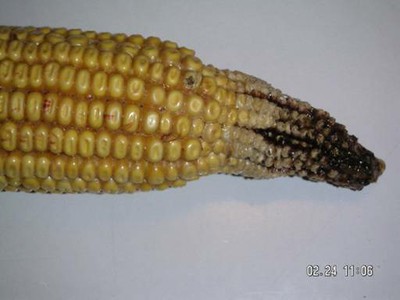Source: P. Thomison, OSU Source: P. Thomison, OSU
Symptoms:
Poor tip fill or unfilled ear tips; little or no kernel development on the last one or more inches of the ear tip. Kernel abortion at tip end of ear at the blister and milk stages; usually associated with poor ovule fertilization at tip. Unfertilized ovules and aborted kernels may both appear dried up and shrunken, but aborted kernels often have a slight yellowish color.
Causes:
Stress conditions during early kernel development, including severe drought and high temperatures; nitrogen deficiencies, high plant populations, foliar diseases, and cloudy weather.
Management:
Follow recommended guidelines for minimizing crop stress, including maintaining appropriate soil fertility, and selecting adapted hybrids and seeding rates consistent for soil yield potential and date of planting. Avoid planting too early in wet soils and adjust planting depth with varying soil conditions. Minimize weed competition with effective herbicide application and/or timely cultivation. Ears exhibiting tipdieback may not always be cause for concern. Favorable growing conditions may result in a larger number of potential kernels per row than normal. So even if corn ear tips are not filled completely, due to poor pollination or kernel abortion, yield potential may not be affected significantly, if at all, because the numbers of kernels per row may still be above normal. The presence of ears consistently filled to the tip may actually indicate that a higher plant population is needed to optimize yields.
References:
Abendroth, L. 2005. Examine corn ears now for clues to earlier stresses. Univ. of Nebraska Extension Crop Watch (September 16, 2005. Available at http://digitalcommons.unl.edu/cgi/viewcontent.cgi?article=1301&context=cropwatch [URL verified 3/28/2019].
Ciampitti, I. 2014. Abnormal Corn Ears. Available at https://www.agronomy.k-state.edu/extension/documents/crop-production/Abnormal_Corn_Ears.pdf [URL verified 3/28/2019]. Kansas State University.
Thomison, P. 2007. Drought and Heat Stress Affecting Corn Yield Potential. C.O.R.N Newsletter 2007-21(July 9, 2007 – July 17, 2007) Available at http://agcrops.osu.edu/newsletters/2007/21#9 [URL verified 3/28/2019].


